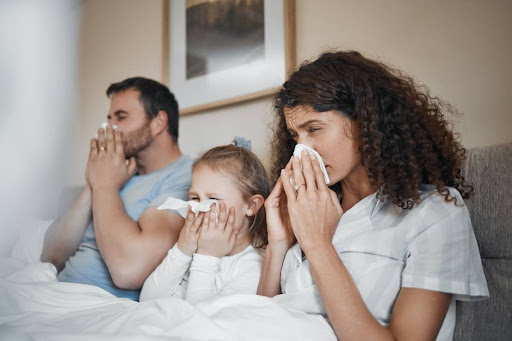Home is supposed to be the place where you feel safe and relaxed. That’s why the word “bacteria” tends to set off alarms for so many homeowners. Nobody wants to picture bacteria buildup hiding in the spaces where their family lives, breathes, and gathers. While most people expect to find it in damp basements or bathrooms, this kind of organic matter has a way of turning up in unexpected places. One of those places is your furnace.
Your furnace plays a sizable role in keeping your home comfortable, yet it can also provide the right mix of moisture, warmth, and hidden spaces that organic matter loves. Learning how to spot the signs of bacterial buildup in your furnace is one of the best ways to protect your home and your health.
Why Bacterial Buildup Finds Its Way Into Furnaces
Believe it or not, your furnace is a prime candidate for bacterial buildup. Moisture from condensation, dust inside the system, and the dark, hidden areas of ducts create an environment where organic matter thrives.
Once it spreads, bacterial buildup in your furnace can make you sick because the system pushes air through vents in every room. That means this organic matter doesn’t stay contained; instead, it travels wherever the air goes.
Common Signs of Bacterial Buildup in Your Furnace
Spotting bacterial buildup isn’t always straightforward, but there are a few telltale clues:
- Musty Odors: If you catch a damp or earthy smell every time your heat kicks on, it may be a sign of bacterial accumulation.
- Visible Growth: Black, green, or white fuzzy spots near vents or inside your furnace panel are red flags.
- Allergy-like Symptoms: Frequent coughing, sneezing, or watery eyes inside your home may mean you’re breathing contaminated air.
- Dust That Looks Odd: Sometimes microbial growth appears as unusual clumps of dust or debris around vents.
- Persistent Humidity Issues: Extra condensation or moisture buildup can create bacterial colony hotspots.
Recognizing these signs of bacterial accumulation in your furnace early is critical because, left untreated, the problem will only grow.
How to Tell if Your Furnace Has Microbial Contamination
You don’t need special equipment to notice potential problems. Here’s how to tell if your furnace has microbial contamination without expert tools:
- Check the air filter. If there are black spots or mildew, that is a strong indicator.
- Look for moisture. Pools of condensation, damp basements, or high humidity levels are warning signs.
- Pay attention to health. An increase in coughing, allergies, or irritation at home can point to spores in the system.
- Notice odors. A damp smell emanating from the vents may indicate that microbial contamination is spreading through your ducts.
These checks can help you identify the problem, but a professional inspection gives you clear answers.
Health Risks Connected to Bacterial Buildup in Furnaces
The risks go far beyond a musty smell. Here are some ways microbial deposits in your furnace can make you sick:
- Allergies may flare with sneezing, runny noses, and itchy eyes.
- Asthma can be triggered more easily.
- Respiratory issues such as cough or shortness of breath may develop.
- Eye or skin irritation may occur.
- Headaches and fatigue can creep in after long exposure.
Many families mistake these problems for seasonal allergies or colds. In reality, the source may be organic matter in the furnace and ducts.
What Steps to Take If You Suspect Microbial Contamination
If you’ve spotted any of the signs we discussed above, it’s likely that you’re dealing with bacterial growth in your HVAC system. In this situation, quick action is important. This organic matter doesn’t disappear on its own. Here is what you should do:
Schedule a Professional Inspection
The first and most important step is to schedule a professional inspection. While you may be able to spot clues on your own, a trained HVAC technician knows exactly how to tell if your furnace has bacterial buildup and confirm the extent of the problem. They have tools and experience that go beyond a flashlight and a quick look. An inspection also rules out other potential causes of odor or poor air quality, so you’re not left guessing.
Consider Professional Duct Cleaning
Bacterial growth doesn’t stay put inside the furnace. Once they spread into your ductwork, every room in your home can be affected. That’s why it’s a good idea to call Quality Heating & Cooling for a duct cleaning in Canton, OH.
Replace the Air Filter Right Away
Your furnace’s air filter is the first line of defense against indoor bacterial growth. If the filter is dirty or clogged, this organic matter can pass through easily and spread further into your home. Replacing the filter with a fresh, high-quality option can improve indoor air quality. It may feel like a small step, but it plays a considerable role in reducing exposure. Make it a habit to change filters regularly to keep bacterial growth and allergens under control.
Fix Moisture and Humidity Issues
Bacteria tend to thrive in moist environments, so tackling water and humidity is essential. Look for leaks around your furnace, condensation inside the system, or damp spots in the basement. Using a dehumidifier can make a major difference by keeping humidity levels in check. Improving ventilation and addressing small leaks right away stops bacterial growth from having the conditions it needs to return. Without addressing moisture, the problem will almost always come back.
When a Furnace Replacement Makes Sense
Sometimes repeated problems with bacterial buildup point to a furnace that’s past its prime. Older systems may struggle with airflow, condensation, or other issues that make this organic matter more likely. If your unit is over 15 years old, it may be time to think about an upgrade.
Are you considering a replacement? The professionals at Quality Heating & Cooling can provide you with a new furnace installation in Canton. Our team will help you select the right system for your home and install it with long-term comfort in mind.
Protect Your Home With Quality Heating & Cooling
Recognizing the early warning signs of bacterial growth helps stop the problem before it spreads. When these issues move into your ductwork, the signs that you have a microbial contamination issue in your HVAC system become even harder to ignore. Taking action quickly with professional help is the best way to protect your home.
Bacterial accumulation in your furnace isn’t something to take lightly. The good news is you don’t have to tackle it alone. At Quality Heating & Cooling, we’ve been serving families in our community since 1985. What started in a garage has grown into a trusted team providing heating and cooling services.
Schedule your appointment today and breathe easier knowing your home is in good hands!

